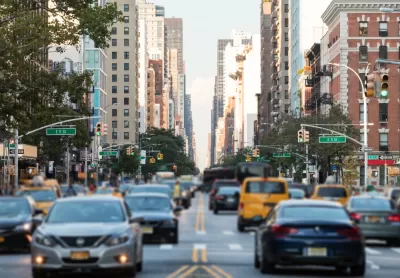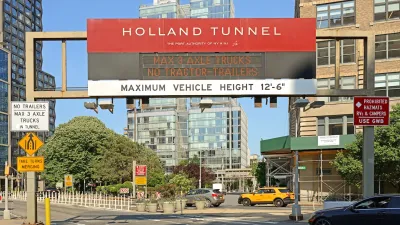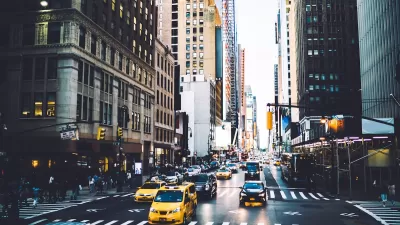Hundreds of people signed up to speak at the city’s first public meeting on the long-delayed plan to charge drivers entering Manhattan’s Central Business District.

New Yorkers got their first opportunity to comment on the city’s proposed congestion pricing plan in the first of six public hearings on the issue. As Catalina Gonella and Phil Corso write in Gothamist, “The plan, which would toll drivers in Manhattan south of 60th Street as much as $23 during rush hour, was designed to lessen traffic congestion by as much as 20%, according to an MTA analysis.”
Close to 400 people signed up to speak at the meeting, which ran late into the night last Thursday. Some expressed concern about the cost to residents in communities that lack subway stations or round-the-clock bus service, such as senior citizens who travel to Manhattan for medical appointments. Others showed support for the plan, hoping it will help improve transit and reduce pollution and traffic deaths.
According to the article, “The affected toll zone, dubbed the ‘Central Business District,’ draws roughly 7.67 million people on the average weekday, according to an MTA study. The capital plan was last pegged at $56 million with about 30% of that being covered by the congestion pricing proposal, the MTA said.”
The program, which was originally scheduled to start collecting revenue in 2021, was delayed repeatedly, including earlier this year when the Federal Highway Administration (FHA) asked the city to answer hundreds of additional questions regarding its environmental impact assessment.
FULL STORY: Commuters sound off at MTA’s first congestion pricing public hearing

Planetizen Federal Action Tracker
A weekly monitor of how Trump’s orders and actions are impacting planners and planning in America.

Congressman Proposes Bill to Rename DC Metro “Trump Train”
The Make Autorail Great Again Act would withhold federal funding to the system until the Washington Metropolitan Area Transit Authority (WMATA), rebrands as the Washington Metropolitan Authority for Greater Access (WMAGA).

The Simple Legislative Tool Transforming Vacant Downtowns
In California, Michigan and Georgia, an easy win is bringing dollars — and delight — back to city centers.

The States Losing Rural Delivery Rooms at an Alarming Pace
In some states, as few as 9% of rural hospitals still deliver babies. As a result, rising pre-term births, no adequate pre-term care and "harrowing" close calls are a growing reality.

The Small South Asian Republic Going all in on EVs
Thanks to one simple policy change less than five years ago, 65% of new cars in this Himalayan country are now electric.

DC Backpedals on Bike Lane Protection, Swaps Barriers for Paint
Citing aesthetic concerns, the city is removing the concrete barriers and flexposts that once separated Arizona Avenue cyclists from motor vehicles.
Urban Design for Planners 1: Software Tools
This six-course series explores essential urban design concepts using open source software and equips planners with the tools they need to participate fully in the urban design process.
Planning for Universal Design
Learn the tools for implementing Universal Design in planning regulations.
Smith Gee Studio
City of Charlotte
City of Camden Redevelopment Agency
City of Astoria
Transportation Research & Education Center (TREC) at Portland State University
US High Speed Rail Association
City of Camden Redevelopment Agency
Municipality of Princeton (NJ)





























